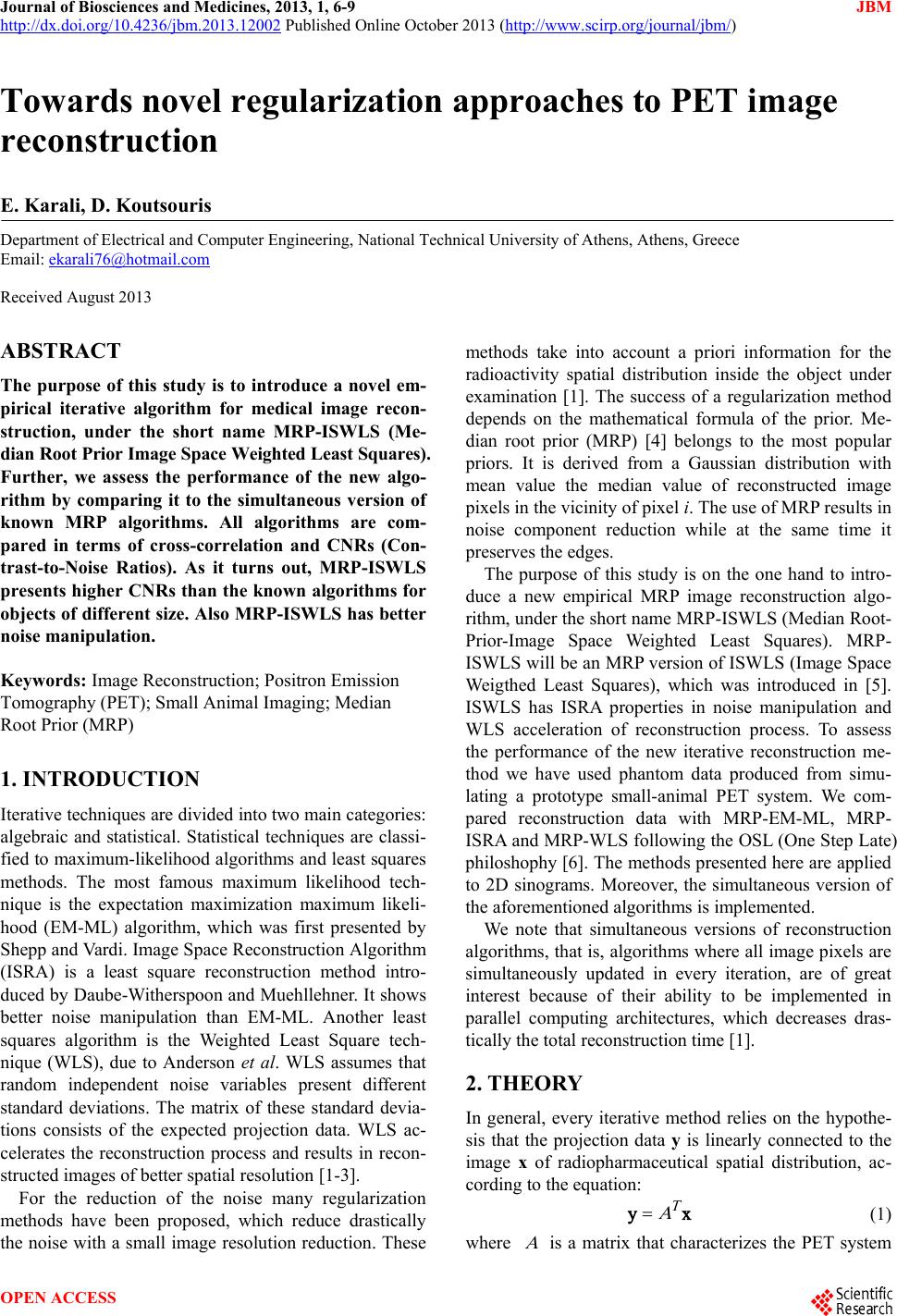
Journal of Biosciences and Medicines, 2013, 1, 6-9 JBM
http://dx.doi.org/10.4236/jbm.2013.12002 Published Online October 2013 (http://www.scirp.org/journal/jbm/)
OPEN ACCESS
Towards n ove l regularization approaches to PET i m age
reconstruction
E. Karali, D. Koutsouris
Department of Electrical and Computer Engineering, National Technical University of Athens, Athens, Greece
Email: ekarali76@hotmail.com
Received August 2013
ABSTRACT
The purpose of this study is to introduce a novel em-
pirical iterative algorithm for medical image recon-
struction, under the short name MRP-ISWLS (Me-
dian Root Prior Image Space Weighted Least Squares).
Further, we assess the performance of the new algo-
rithm by comparing it to the simultaneous version of
known MRP algorithms. All algorithms are com-
pared in terms of cross-correlation and CNRs (Con-
trast-to-Noise Ratios). As it turns out, MRP-ISWLS
presents higher CNRs than the known algorithms for
objects of different size. Also MRP-ISWLS has better
noise manipulation.
Keywords: Image Reconstruction; Positron Emission
Tomography (PET); Small Animal Imaging; Median
Root Prior (MRP)
1. INTRODUCTION
Iterative techniques are divided into two main categories:
algebraic and statistical. Statistical techniques are classi-
fied to maximum-likelihood algorithms and least squares
methods. The most famous maximum likelihood tech-
nique is the expectation maximization maximum likeli-
hood (EM-ML) algorithm, which was first presented by
Shepp and Vardi. Image Space Reconstruction Algorithm
(ISRA) is a least square reconstruction method intro-
duced by Daube-Witherspoon and Muehllehner. It shows
better noise manipulation than EM-ML. Another least
squares algorithm is the Weighted Least Square tech-
nique (WLS), due to Anderson et al. WLS assumes that
random independent noise variables present different
standard deviations. The matrix of these standard devia-
tions consists of the expected projection data. WLS ac-
celerates the reconstruction process and results in recon-
structed images of better spatial resolution [1-3].
For the reduction of the noise many regularization
methods have been proposed, which reduce drastically
the noise with a small image resolution reduction. These
methods take into account a priori information for the
radioactivity spatial distribution inside the object under
examination [1]. The success of a regularization method
depends on the mathematical formula of the prior. Me-
dian root prior (MRP) [4] belongs to the most popular
priors. It is derived from a Gaussian distribution with
mean value the median value of reconstructed image
pixels in the vicinity of pixel i. The use of MRP results in
noise component reduction while at the same time it
preserves the edges.
The purpose of this study is on the one hand to intro-
duce a new empirical MRP image reconstruction algo-
rithm, under the short name MRP-ISWLS (Median Root-
Prior-Image Space Weighted Least Squares). MRP-
ISWLS will be an MRP version of ISWLS (Image Space
Weigthed Least Squares), which was introduced in [5].
ISWLS has ISRA properties in noise manipulation and
WLS acceleration of reconstruction process. To assess
the performance of the new iterative reconstruction me-
thod we have used phantom data produced from simu-
lating a prototype small-animal PET system. We com-
pared reconstruction data with MRP-EM-ML, MRP-
ISRA and MRP-WLS following the OSL (One Step Late)
philoshophy [6]. The methods presented here are applied
to 2D sinograms. Moreov e r, the simultaneous version of
the aforementioned algorithms is implemented.
We note that simultaneous versions of reconstruction
algorithms, that is, algorithms where all image pixels are
simultaneously updated in every iteration, are of great
interest because of their ability to be implemented in
parallel computing architectures, which decreases dras-
tically the total reconstruction time [1].
2. THEORY
In general, every iterative method relies on the hypothe-
sis that the projection data y is linearly connected to the
image x of radiopharmaceutical spatial distribution, ac-
cording to the equation:
(1)
where
is a matrix that characterizes the PET system